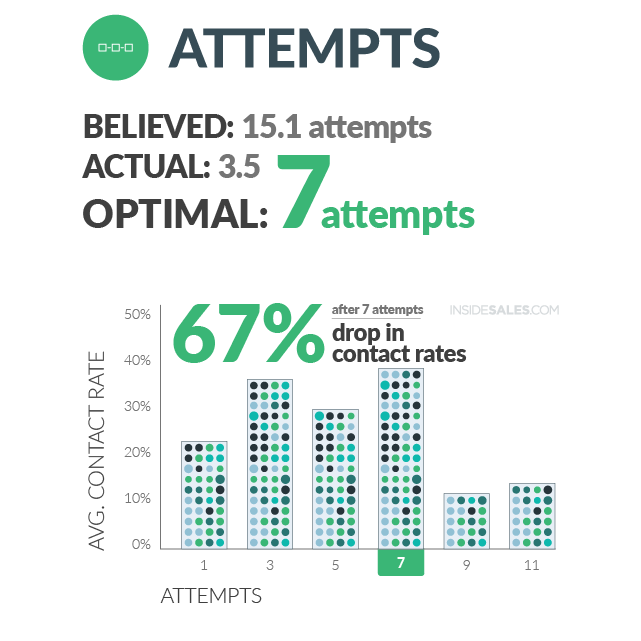How to Build the Ultimate Outbound Sales Cadence
You’re not going to believe this. We just completed our State of Sales Development report, the largest study ever on sales development. We now have nearly 1,500 companies giving us insights into how they structure their teams, buy technology, and how they structure their sales cadence to move leads down their pipeline.
Outbound Sales Cadences – Going Beyond the Surveys
One of the biggest findings was — what are reps actually doing when it comes to outbound sales cadences? If you’ve been in the sales industry for a while, you’ve probably heard of studies that mandate we should contact people 15 or 30 times when prospecting. Have you heard of those? The thing is, those studies are surveys and like most data, they need to be interpreted in the right context.
I wanted to go beyond surveys.
I wanted to know what companies were really doing when it came to their sales cadence so we decided to do the following experiment.
1) Ask hundreds of companies what they believe their sales cadence is.
2) Examine the XANT big data set to see what people are actually doing and what they should be doing.
The Pillars of a Sales Cadence
We currently have the largest sales data base in the world with 6.7 trillion data points. That’s trillion with a T. I can’t believe this experiment had never been done before. I was excited as I’ve ever been about sales data with this idea. To make sure make sure we did it right, we studied the data across the pillars of a sales cadence. This is really important so listen to this. The pillars of a cadence are:
1) Attempts – the number of total touches on a lead or contact.
2) Media – The different communication methods used
3) Duration – The time between the first activity in your cadence and the last activity in your cadence.
4) Spacing – The time between each activity.
5) Content – What you actually say or write in a phone call or email.
Okay, so with that basis, here is what we discovered. Get ready to have your minds blown.
Attempts
Let’s first look at attempts or how many total touches occur on a lead or contact. When we surveyed the companies and they told us they believed their reps did 15.1 total attempts on average. That’s not surprising: if you google how many attempts companies should be doing, you’ll see a lot of references to ~15.
Remember though that this is what companies ‘said’ they did. The question then arises, what does the data say they actually did?
When we looked at the XANT big data set we found that the typical rep was doing 3.5 attempts on average. That’s a big difference between believed and actual. I think I go to the gym three times a week but I never actually go.
Now, that’s all interesting, but was was optimal? Well, optimal was 7 attempts. In fact, if you go over 7 attempts on an outbound cadence your ability to contact someone drops by 67%. That’s huge!
One thing that we saw a lot in the data is this concept of ‘recycling’ and it’s important to mention here because you need to start practicing this concept. It’s not that you only hit a target account seven times total. You should run a ‘play’ with around seven attempts and then let the contact sit for a few weeks and then run another play and hit them seven more times. You can repeat this as many times as needed.
Media
Next let’s look at the media. Media is the different communication methods a rep can use when prospecting. It’s important to remember that a rep can use the phone, VM, email, social, direct mailer, video, chat and text. When we asked the companies how many of these methods they used in their typical sales cadence, they reported using 4.
When we examined the big data set to see how many communication methods they actually use we found reps are most often using 2.0 total communication methods. Fascinating data, but what is optimal? The optimal number appears to be 3+.
In fact, if you use 3+ communication methods you increase your contact rates by 4x as compared to just using one method.
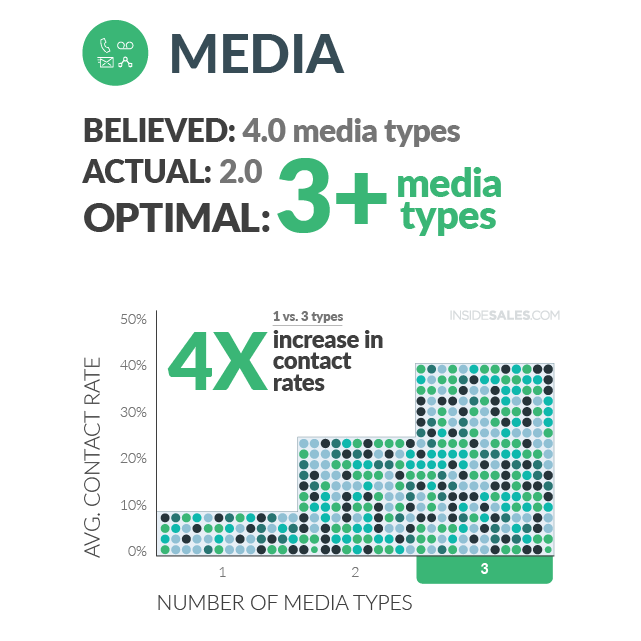
Duration
Duration is the length of a cadence from the first touch to the last touch. When we asked companies what their average duration length was for their sales cadences, companies believed they were sitting at around 28 days. That means if the first touch happened on Jan 1, the last touch of the cadence happened on Jan 28.
When we looked at the XANT big data set to see what the actual duration of a cadence was, we found the average was 24.6 days so pretty close to what people believed they did.
Interestingly, on duration the optimal duration of cadences was 8 days. In fact, if people go over 8 days, contact rates drop by nearly 2/3. This one is hard to swallow. I’ve often believed cadences should, especially outbound, should be more like 3 weeks. It appears that keeping the cadences tighter and again recycling is the better way to go.
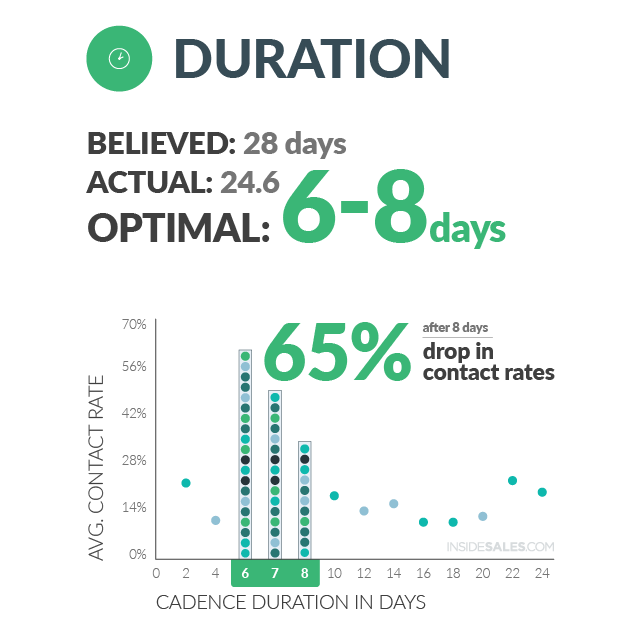
Spacing
Spacing is the time between each of the activities in a sales cadence. If you call some at noon on Monday and then call them again on Tuesday, the spacing would be 24 hours between those two touches. When we asked companies what they thought their spacing was, people reported 1.9 days.
When we compared that with actual data we found spacing was on average 10.4 days which was a huge difference then what people believed. Interestingly, what people believed aligned with what was optimal as optimal was 1-2 days.
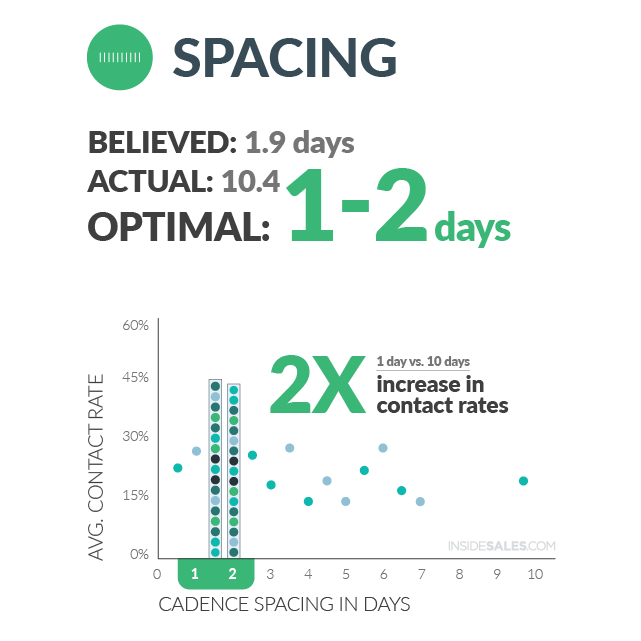
Content
Content is a tough cookie to crack, but we tried to do it anyways. When we looked at content we needed to look at it in relation to each of the communication media used. Some were fairly easy to review and some were really difficult.
Here is what we found. With email, there are two big trends happening:
1) The short form email that is extremely personalized — that is just 25-50 words, but carefully planned and contain messaging which speaks to the prospect’s pain point. A lot of sales reps are successful with these short, to-the-point emails.
2) The other trend is long form emails — they are killing it. A long form email might be 500-700 words, but can go as high as 1800 to 2000.
Given these extremes that work very well for email outreach, it makes sense that the optimal number that we found for email length was an average of 300 words.
Voicemail is not dead, and it may get a boost with some of the automatic transcribing services services coming out lately from major phone operating systems providers. Shorter is better here, with under 30 seconds as a hard and fast rule.
Video in email is another big trend, but only 10.4% of emails contain a video according to our data. The best videos are short or under 60 seconds. Research is showing InMails need to be under 150 words and text messages under 160 characters.
Direct mail is also one effective media for sales messages, as 64% of executives report they would read a direct mail piece. The most effective reported type of direct mailer is hand-written note cards, an oldie but goldie.
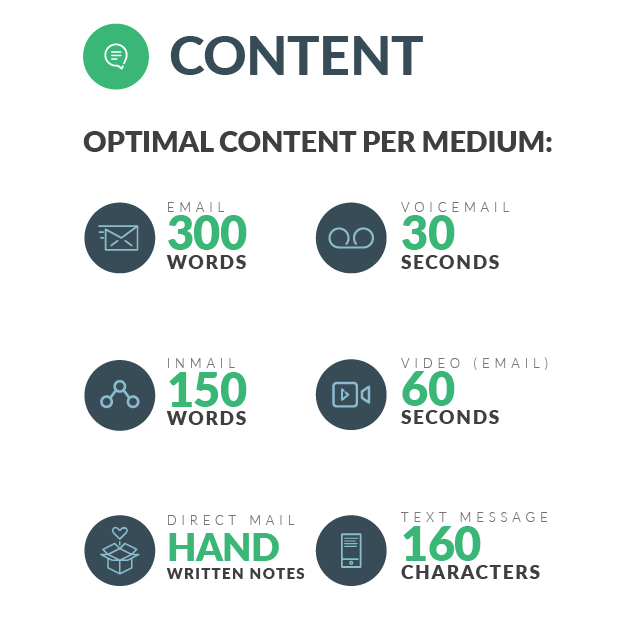
Sales cadence is so foundational to prospecting if you are not doing it, you’re crazy. The data shows us that sales reps have a tendency to over-estimate what they do and when they do it, and the reality is painful to see. Previous studies we did showed that most sales reps stop after one phone call or one email, and that just needs to stop.
We need to start talking about what is optimal when it comes to building a cadence, and this study is a breakthrough in discovering what believe is optimal vs is what actually is optimal.
If you’d like to learn more about the study go here to get the infographic.
If you’d like to download the State of Sales Development research report go here.

